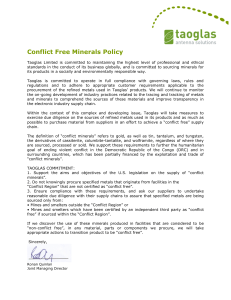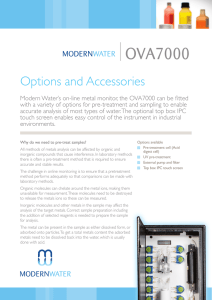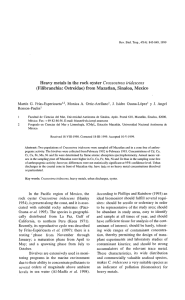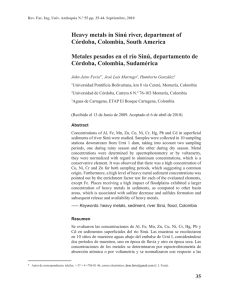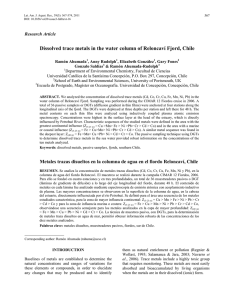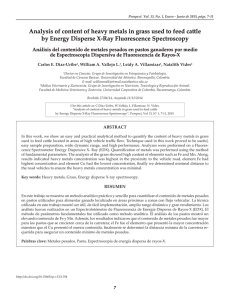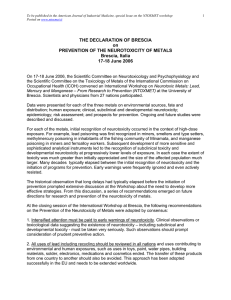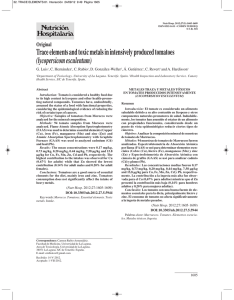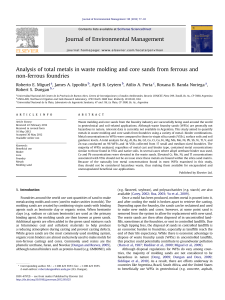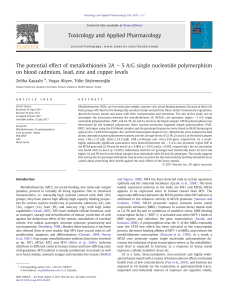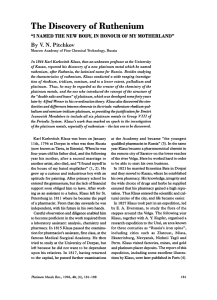Trace metals in the coastal waters and organisms of the austral
Anuncio
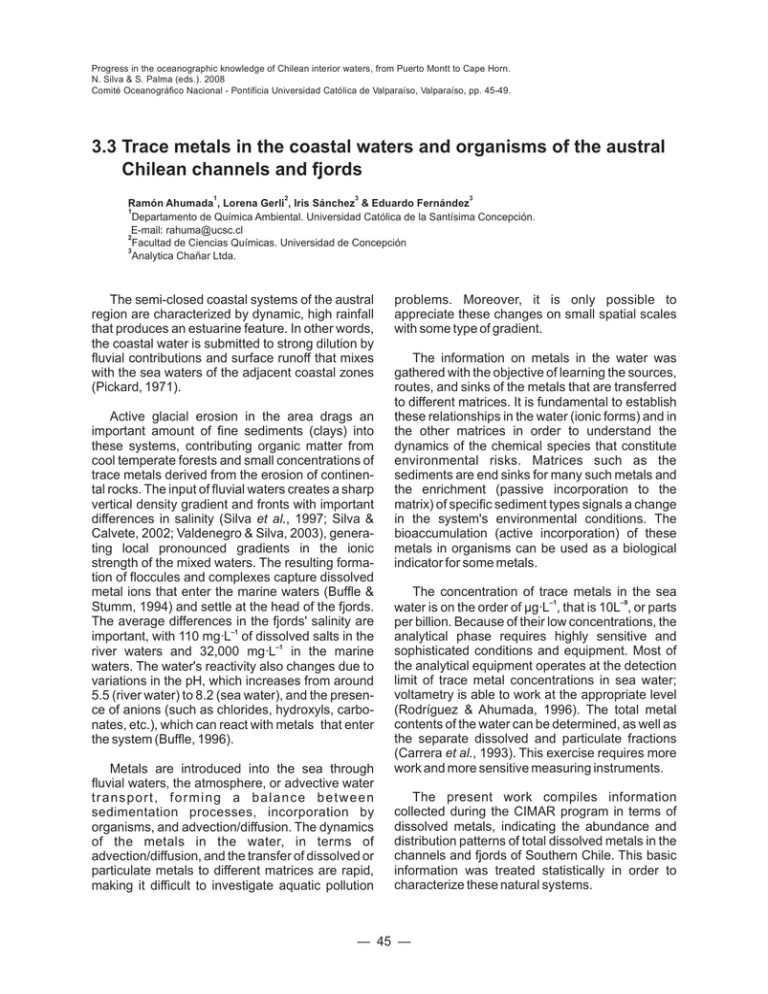
Progress in the oceanographic knowledge of Chilean interior waters, from Puerto Montt to Cape Horn. N. Silva & S. Palma (eds.). 2008 Comité Oceanográfico Nacional - Pontificia Universidad Católica de Valparaíso, Valparaíso, pp. 45-49. 3.3 Trace metals in the coastal waters and organisms of the austral Chilean channels and fjords 1 2 3 3 Ramón Ahumada , Lorena Gerli , Iris Sánchez & Eduardo Fernández 1 Departamento de Química Ambiental. Universidad Católica de la Santísima Concepción. E-mail: rahuma@ucsc.cl 2 Facultad de Ciencias Químicas. Universidad de Concepción 3 Analytica Chañar Ltda. The semi-closed coastal systems of the austral region are characterized by dynamic, high rainfall that produces an estuarine feature. In other words, the coastal water is submitted to strong dilution by fluvial contributions and surface runoff that mixes with the sea waters of the adjacent coastal zones (Pickard, 1971). Active glacial erosion in the area drags an important amount of fine sediments (clays) into these systems, contributing organic matter from cool temperate forests and small concentrations of trace metals derived from the erosion of continental rocks. The input of fluvial waters creates a sharp vertical density gradient and fronts with important differences in salinity (Silva et al., 1997; Silva & Calvete, 2002; Valdenegro & Silva, 2003), generating local pronounced gradients in the ionic strength of the mixed waters. The resulting formation of floccules and complexes capture dissolved metal ions that enter the marine waters (Buffle & Stumm, 1994) and settle at the head of the fjords. The average differences in the fjords' salinity are 1 important, with 110 mg·L– of dissolved salts in the river waters and 32,000 mg·L–1 in the marine waters. The water's reactivity also changes due to variations in the pH, which increases from around 5.5 (river water) to 8.2 (sea water), and the presence of anions (such as chlorides, hydroxyls, carbonates, etc.), which can react with metals that enter the system (Buffle, 1996). Metals are introduced into the sea through fluvial waters, the atmosphere, or advective water transport, forming a balance between sedimentation processes, incorporation by organisms, and advection/diffusion. The dynamics of the metals in the water, in terms of advection/diffusion, and the transfer of dissolved or particulate metals to different matrices are rapid, making it difficult to investigate aquatic pollution problems. Moreover, it is only possible to appreciate these changes on small spatial scales with some type of gradient. The information on metals in the water was gathered with the objective of learning the sources, routes, and sinks of the metals that are transferred to different matrices. It is fundamental to establish these relationships in the water (ionic forms) and in the other matrices in order to understand the dynamics of the chemical species that constitute environmental risks. Matrices such as the sediments are end sinks for many such metals and the enrichment (passive incorporation to the matrix) of specific sediment types signals a change in the system's environmental conditions. The bioaccumulation (active incorporation) of these metals in organisms can be used as a biological indicator for some metals. The concentration of trace metals in the sea water is on the order of µg·L–1, that is 10L–9, or parts per billion. Because of their low concentrations, the analytical phase requires highly sensitive and sophisticated conditions and equipment. Most of the analytical equipment operates at the detection limit of trace metal concentrations in sea water; voltametry is able to work at the appropriate level (Rodríguez & Ahumada, 1996). The total metal contents of the water can be determined, as well as the separate dissolved and particulate fractions (Carrera et al., 1993). This exercise requires more work and more sensitive measuring instruments. The present work compiles information collected during the CIMAR program in terms of dissolved metals, indicating the abundance and distribution patterns of total dissolved metals in the channels and fjords of Southern Chile. This basic information was treated statistically in order to characterize these natural systems. — 45 — Ahumada R., et al. 76º 75º 74° 73º 76° 72°W 75° é I. Chilo 14 18 B. del Guafo 28 29 33 30 32 44º C. King 92 C. Fallos E. Steffen 14 13 12 E. Mitchel 9 8 C. Baker 10 5 91 20 87 G. Corcovado C. Ladrillero C. Picton C. Moraleda S. Iceberg C. Messier A. Inglesa 28 77 S. Eyre 24 29 31 25 E. Falcon 32 35 C. Darwin 71 68 65 64 46º Laguna San Rafael C. Puyuguapi I. Meninea 43 78 81 F. Aysén 73 45 46 77 79 80 82 75 48 59 58 E. Quitralco 62 60 56 55 E. Cupquelán 51 57 70 43 C. Concepción 49° 50° S. Penguin 36 41 85 69 S. Europa 39 E. Peel 76 74 E. Calvo E. Amalia 75 C. Sarmiento 51° E. Las Montañas 68 51 57 E. Nelson C. Smyth 65 Str ai t of G. Elefantes CIMAR 1 Fiordos Ma gel CIMAR 2 Fiordos 48° 22 C. Trinidad C. Jacaf 91 89 93 G. de Penas 18 Tictoc 34 36 35 C. Pulluche 9 10 21 12 13 E. Reñihue 22 23 24 25 I. Desertores 26 43º 45º í cav elon E. R E. Comau 7 103 47°S Pacific Ocean Pacific Ocean 42º B. San Quintín Puerto Montt S. Reloncaví 1 2 G. Ancud 73°W 74° 41°S lan 58A 52° 55 62 53° 47º Water samples Organism samples Water and organism samples Figure 1: Geographic position of the stations sampled to determine trace metals in the sea water and organisms. –1 –1 The first phase in the study of four dissolved metals (Cd, Cu, Pb, Zn) in the sea water, carried out between Puerto Montt and Laguna San Rafael (northern zone), involved the collection of samples from 53 stations (Fig. 1); 92 samples and their respective replicates were analyzed for four metals (Rodríguez et al., 1998). The second phase covered the area between Golfo de Penas and Strait of Magellan (central zone); the 96 samples taken at 25 stations (Fig. 1) were subjected to 288 analyses for the same four metals. The metals were determined through anodic redissolution polarography (Buffle, 1988). Moreover, the metal contents of the soft tissues of different marine invertebrates were determined through inductively coupled plasma atomic emission spectrometry. The dissolved metal concentrations in the channels and fjords of the central zone were similar and the absolute concentration values higher, as were the coefficients of variation. The sensitivity of the method used was defined through the detection limit (DL) and the quantification limit (QL), which were estimated to be 0.02-0.07 µg·L–1 for Cd; 0.05-0.12 µg·L–1 for Pb; The abundance ranking of the total dissolved metal concentrations in the samples, in decreasing order, was: Zn > Cu > Pb > Cd. This relationship was observed in both analyzed zones (Tables I and II). 0.3-0.6 µg·L for Cu, and 0.4-1.0 µg·L for Zn. Concentrations in the northern zone were 0.021.78 µg·L–1 for Cd; 0.3-11.1 µg·L–1 for Cu; 0.05-4.20 µg·L–1 for Pb; and 0.4-46.4 µg·L–1 for Zn. Table I shows the average concentrations measured in three depth strata of the water column. In general, the concentration values of the metals in the water were low, observed at the detection limit of the method used for their determination. This and the scant concentrations detected resulted in high variability and a high coefficient of variation. — 46 — Trace metals in the coastal waters and organisms of the austral Chilean channels and fjords –1 Table I: Concentrations of dissolved metals (ìg L ) in different depth strata in the channels and fjords of the northern zone. SD= standard deviation, CV= coefficient of variation. Statistics Cd Cu Pb Zn Mean SD CV % Mean SD CV % Mean SD CV % 0.02 0.41 268 0.04 0.05 136 0.03 0.03 91 2.76 1.86 1.04 1.0 11.78 10.78 68 2.58 2.43 95 1.25 0.85 96 0.77 0.92 120 0.44 0.36 107 8.93 10.88 122 6.42 7.87 68 83 123 Surface water (10-30 m) n=64 Mid water (50-200 m) n=152 Deep water (250-800 m) n=60 –1 Table II: Concentrations of dissolved metals (ìg L ) in different depth strata in the channels and fjords of the central zone. SD= standard deviation, CV= coefficient of variation. Statistics Cd Cu Pb Zn Mean SD CV % Mean SD CV % Mean SD CV % 0.076 0.16 208 0.033 0.075 231 0.090 0.23 266 6.94 5.88 0.71 0.69 8.47 6.61 85 5.13 4.30 84 5.77 3.98 97 0.72 1.11 154 0.99 1.23 78 14.83 18.62 126 7.93 7.25 69 124 91 Surface water (10-30 m) n=68 Mid water (50-200 m) n=134 Deep water (250-800 m) n=86 –1 Table III: Average concentrations of tarce metals (ìg L ) in soft tissues of different intertidal and sublitoral species (N= 21). Trace metals Mytilus chilensis Choromytilus chorus Aulacomya ater Chlamys patagonica Protothaca thaca Loxechinus albus Cd Cu Pb Zn 0.9 ± 0.3 5.7 ± 3.0 0.7 ± 0.8 83.1 ± 34.7 0.9 ± 0.1 4.6 ± 0.5 0.1 ± 0.1 87.1 ± 51.5 0.82 ± 0.4 6.2 ± 3.0 0.2 ± 0.2 58.0 ± 20.6 0.2 ± 0.1 3.4 ± 0.2 0.2 ± 0.1 53.7 ± 1.0 0.9 ± 0.3 6.2 ± 1.6 0.3 ± 0.3 65.8 ± 16.6 0.7 ± 0.4 5.6 ± 2.7 0.1 ± 0.1 42.6 ± 39.4 Moreover, in the central zone, different littoral and sub-littoral species were sampled in order to analyze the trace metal contents in their soft tissues (Table III). The abundance ranking for the concentration of total metals in these organisms was Zn > Cu > Cd > Pb, indicating that Pb is the most difficult element for the organisms to bioacummulate in natural systems (Table III). The concentration values of the dissolved metals obtained in the water analyses were used to establish the “bioaccumulation factors” for the different species analyzed in this zone (Table IV). These results reveal a bioaccumulation ranking of Cu > Pb > Zn > Cd. Of the different species analyzed, the subtidal species Choromytilus chorus concentrated the greatest quantity of metals. Finally, the results found for the austral Chilean channels and fjords were compared with the concentration values recorded in natural waters and other benthic species from other geographic sites with different degrees of contamination (Table V). This research provides an important reference as to the metal contents in the austral channel and fjord zone. The matrices studied in this work clearly show a pristine zone without anthropic contributions. Nonetheless, semi-closed systems or those having restricted circulation are high-risk areas in terms of pollution. The determination of the trace metal concentrations allowed the characterization of the different sites and indicated the coastal activities that would adequately protect the region, which is a resource for settlement and aquaculture production, while valuing its environmental quality. — 47 — Ahumada R., et al. Table IV: Bioaccumulation factor for trace metals estimated for the studied species (taken from Ahumada & Gerli, 2002). Trace Metals Mytilus chilensis Choromytilus chorus Aulacomya ater Chlamys albus Protothaca patagonica Loxechinus thaca Cd Cu Pb Zn 8.4 * 10 –5 1.2 * 10 –3 2.4 * 10 –4 1.0 * 10 –4 8.4 * 10 –5 1.5 * 10–3 7.1 * 10 –3 9.7 * 10 –5 9.3 * 10 -5 1.1 * 10 –3 3.6 * 10 –3 1.5 *10 –4 3.8 * 10 –4 2.0 * 10 –3 3.6 * 10 –3 1.6 * 10 –3 8.4 * 10 –5 1.1 * 10 –3 2.4 * 10 –3 1.3 * 10 –4 1.1 * 10 –4 1.2 * 10 –3 7.1 * 10 –3 2.0 * 10 –4 Table V: Intervals of total metal concentrations in the water and organisms from different geographic sites, compared with the concentrations obtained in this study. Metals Northern Waters -1 m gL Central Waters -1 m gL Cd Cu Pb Zn 0.02 - 0.5 0.30 - 1.69 0.05 - 0.41 2.56 - 3.20 0.03 - 0.09 5.13 - 6.94 0.71 - 0.99 7.93 - 14.8 Natural 1 Waters m M 0.003 - 0.8 2 – 35 0.005 - 2.4 0.3 – 28 Organisms. Organisms. 2 3 Central Zone Rias Gallegas -1 -1 m g g dw m g g dw 0.2 - 0.9 3.4 - 6.2 0.1 - 0.7 42.6 - 87.1 0.4 - 1,0 12 - 29.5 3.9 - 30.1 190 - 997 Organisms. 4 San Vicente -1 m g g dw 1.9 - 8.0 7.6 - 13.0 0.3 - 2.6 70.0 - 210 dw: dry weight 1 Hart & Hines (1995). 2 Ahumada & Gerli (2002). 3 Soft tissues Mytilus galloprovincialis in the rias Gallegas (Puentes et al., 1996 cited in Prego & Cobelo-García, 2003). 4 Soft tissues Mytilus edulis in San Vicente (Ahumada, 1994). From a scientific point of view, it is important to identify the processes that determine an area's concentration balance and geochemistry in the absence of environmental pressure. With this information, said processes can be understood and the area's uses regulated. Moreover, possible lines of remediation can be defined before the water quality deteriorates. Thus, standards of usage can be established based on the dynamics of the water bodies in relation to the baseline values, thereby avoiding changes in the environmental conditions. The maintenance of their pristine conditions is the most valuable contribution that these systems can make to all possible activities and uses. References Ahumada, R. 1994. Nivel de concentración e índice de bioacumulación para metales pesados (Cd, Cr, Hg, Ni, Cu, Pb, y Zn) en tejidos de invertebrados bénticos de bahía San Vicente, Chile. Rev. Biol. Mar., Valparaíso, 29(1): 77-87. Ahumada, R. & L. Gerli. 2002. Determinación de metales pesados en organismos bentónicos colectados en la zona de Campos de Hielo Sur (48º52º S), Chile. Resúmenes III Jornadas Chilenas de Física y Química Ambiental. Centro Nacional del Medio Ambiente. Santiago. Buffle, J. 1988. Studies of complexation properties by voltametrics methods. Chapter 9. In: M.R. Mansson & D. Midgley (eds.). Complexation reaction in aquatic systems. An analytical approach. Ellis Horwood, Chichester, 692 pp. Buffle, J. 1996. Metals speciation by electrochemical methods. In: A. Tessier & Dr. Turner (eds.). Metals speciation and bioavaibility in aquatic systems. Wiley & Sons, New York. Vol 3: 420 pp. Buffle, J. & W. Stumm. 1994. General chemistry of aquatic system. In: J. Buffle & R. De Vitre (eds.). Chemical and biological regulation of aquatic systems. Lewis Publishers, Boca Ratón, 385 pp. Carrera, M. E., P. Valenta, R. Ahumada & V. Rodríguez. 1993. Determinación voltamétrica de metales trazas en la columna de agua y sedimentos en bahía de Concepción. Rev. Biol. Mar., Valparaíso, 28(1): 151163. — 48 — Trace metals in the coastal waters and organisms of the austral Chilean channels and fjords Hart, B. T. & T. Hines. 1995. Trace elements in rivers. In: B. Salbu & E. Steinnes (eds.). Trace elements in natural waters. CRC Press, Boca Ratón, pp. 203221. sur de Chile. Congreso de la Sociedad Chilena de Química. División de Química Analítica y Ambiental. Universidad Católica del Norte. Antofagasta, Libro de Resúmenes, pp. 15-16. Pickard, G. 1971. Some physical oceanographic features of inlets of Chile. J. Fish. Res. Bd. Can., 28: 1077-1106. Silva, N., & C. Calvete. 2002. Características oceanográficas físicas y químicas de canales australes chilenos entre el golfo Penas y el estrecho de Magallanes (Crucero CIMAR Fiordo 2). Cienc. Tecnol. Mar, 25(1): 23-88. Prego, R. & A. Cobelo-García. 2003. Twentieth century overview of heavy metals in Galician Rias (NW Iberian Peninsula). Environ. Pollut., 121: 425-452. Rodríguez, V. & R. Ahumada. 1996. Concentración de metales traza en la columna de agua en la región norte de los fiordos y canales del sur de Chile. Resultados Crucero CIMAR-Fiordo 1. Resúmenes Ampliados. Comité Oceanográfico Nacional, Valparaíso, pp. 41-48. Rodríguez, V., A. Reyes & R. Ahumada. 1998. Determinación de metales traza en la columna de agua en la región norte de los fiordos y canales del Silva, N., C. Calvete & H. A. Sievers. 1997. Características oceanográficas físicas y químicas de canales australes chilenos entre Puerto Montt y laguna San Rafael (Crucero CIMAR-Fiordo 1). Cienc. Tecnol. Mar, 20: 23-106. Valdenegro, A. & N. Silva. 2003. Caracterización física y química de la zona de canales y fiordos australes de Chile entre el estrecho de Magallanes y cabo de Hornos (CIMAR 3 Fiordos). Cienc. Tecnol. Mar, 26(2): 19-60. — 49 —
